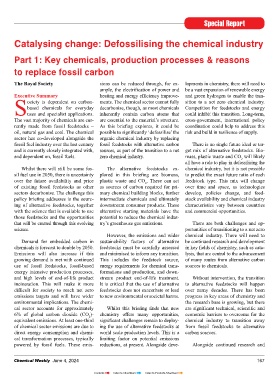Page 167 - CW E-Magazine (4-6-2024)
P. 167
Special Report
Catalysing change: Defossilising the chemical industry
Part 1: Key chemicals, production processes & reasons
to replace fossil carbon
The Royal Society sions can be reduced through, for ex- lopments in chemistry, there will need to
ample, the electrification of power and be a vast expansion of renewable energy
Executive Summary heating and energy efficiency improve- and green hydrogen to enable the tran-
ociety is dependent on carbon- ments. The chemical sector cannot fully sition to a net zero chemical industry.
based chemicals for everyday decarbonise, though, as most chemicals Competition for feedstocks and energy
Suses and specialist applications. inherently contain carbon atoms that could inhibit this transition. Long-term,
The vast majority of chemicals are cur- are essential to the material’s structure. cross-government, international policy
rently made from fossil feedstocks – As this briefing explores, it could be coordination could help to address this
oil, natural gas and coal. The chemical possible to significantly ‘defossilise’ the risk and build in resilience of supply.
sector has co-developed alongside the organic chemical industry by replacing
fossil fuel industry over the last century fossil feedstocks with alternative carbon There is no single future ideal or tar-
and is currently closely integrated with, sources, as part of the transition to a net get mix of alternative feedstocks. Bio-
and dependent on, fossil fuels. zero chemical industry. mass, plastic waste and CO will likely
2
all have a role to play in defossilising the
Whilst there will still be some fos- The alternative feedstocks ex- chemical industry, but it is not possible
sil fuel use in 2050, there is uncertainty plored in this briefing are biomass, to predict the exact future ratio of each
over the future availability and price plastic waste and CO . These can act feedstock type. This mix will change
2
of existing fossil feedstocks as other as sources of carbon required for pri- over time and space, as technologies
sectors decarbonise. The challenge this mary chemical building blocks, further develop, policies change, and feed-
policy briefing addresses is the sourc- intermediate chemicals and ultimately stock availability and chemical industry
ing of alternative feedstocks, together downstream consumer products. These characteristics vary between countries
with the science that is available to use alternative starting materials have the and commercial opportunities.
those feedstocks and the opportunities potential to reduce the chemical indus-
that will be created through this evolving try’s greenhouse gas emissions. There are both challenges and op-
science. portunities of transitioning to a net zero
However, the emissions and wider chemical industry. There will need to
Demand for embedded carbon in sustainability factors of alternative be continued research and development
chemicals is forecast to double by 2050. feedstocks must be carefully assessed in key fields of chemistry, such as cata-
Emissions will also increase if this and minimised to inform any transition. lysis, that are central to the advancement
growing demand is met with continued This includes the feedstock source, of many routes from alternative carbon
use of fossil feedstocks, fossil-based energy requirements for chemical trans- sources to chemicals.
energy intensive production processes, formations and production, and down-
and high levels of end-of-life product stream product end-of-life treatment. Without intervention, the transition
incineration. This will make it more It is critical that the use of alternative to alternative feedstocks will happen
difficult for society to reach net zero feedstocks does not exacerbate or lead over many decades. There has been
emissions targets and will have wider to new environmental or societal harms. progress in key areas of chemistry and
environmental implications. The chemi- the research base is growing, but there
cal sector accounts for approximately Whilst this briefing finds that new are significant technical, scientific and
6% of global carbon dioxide (CO )- chemistry offers many opportunities, economic barriers to overcome for the
2
equivalent emissions. At least one-third significant challenges remain to deploy- chemical industry to transition away
of chemical sector emissions are due to ing the use of alternative feedstocks at from fossil feedstocks to alternative
direct energy consumption and chemi- world scale production levels. This is a carbon sources.
cal transformation processes, typically limiting factor on potential emissions
powered by fossil fuels. These emis- reductions, at present. Alongside deve- Alongside continued research and
Chemical Weekly June 4, 2024 167
Contents Index to Advertisers Index to Products Advertised

